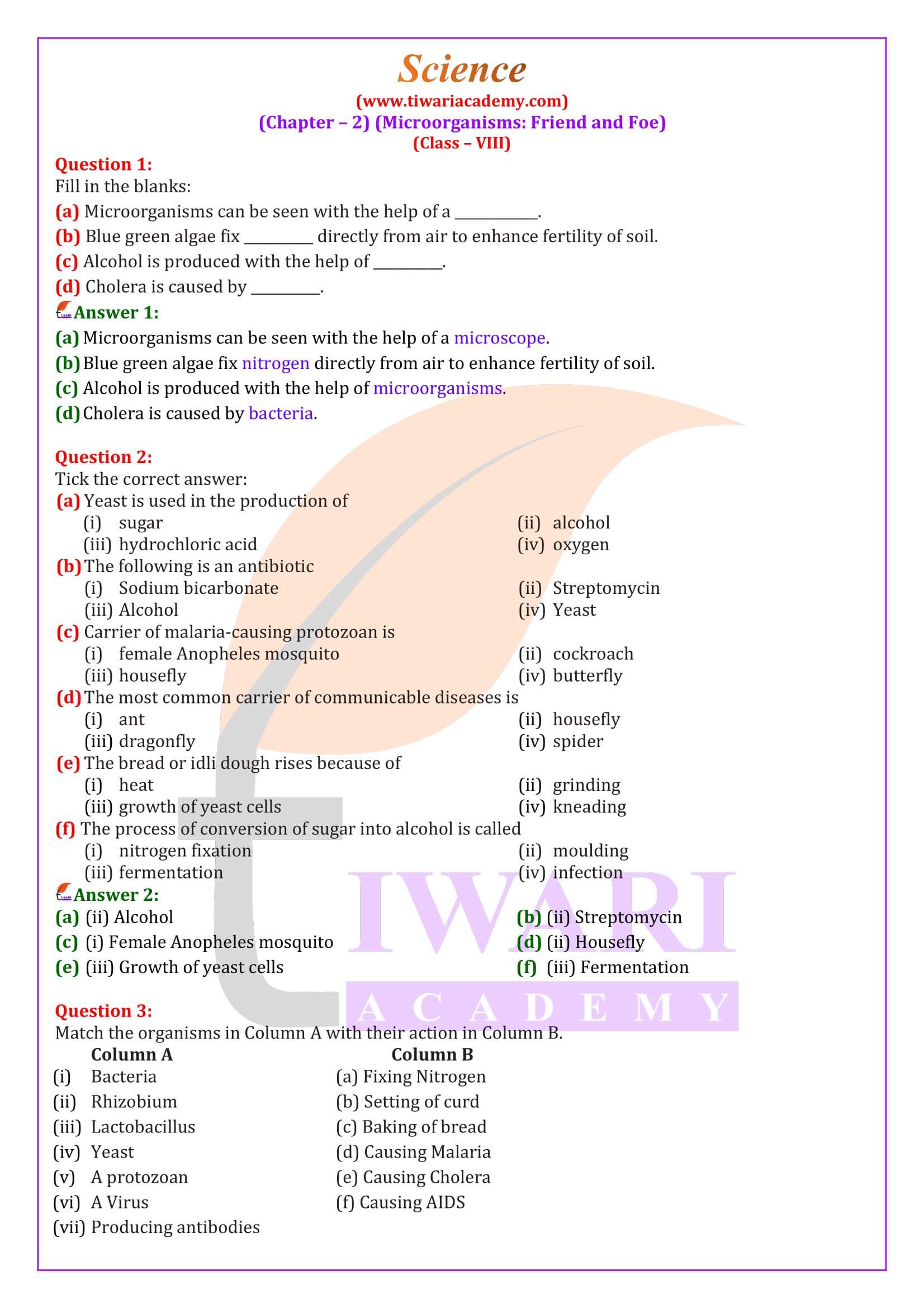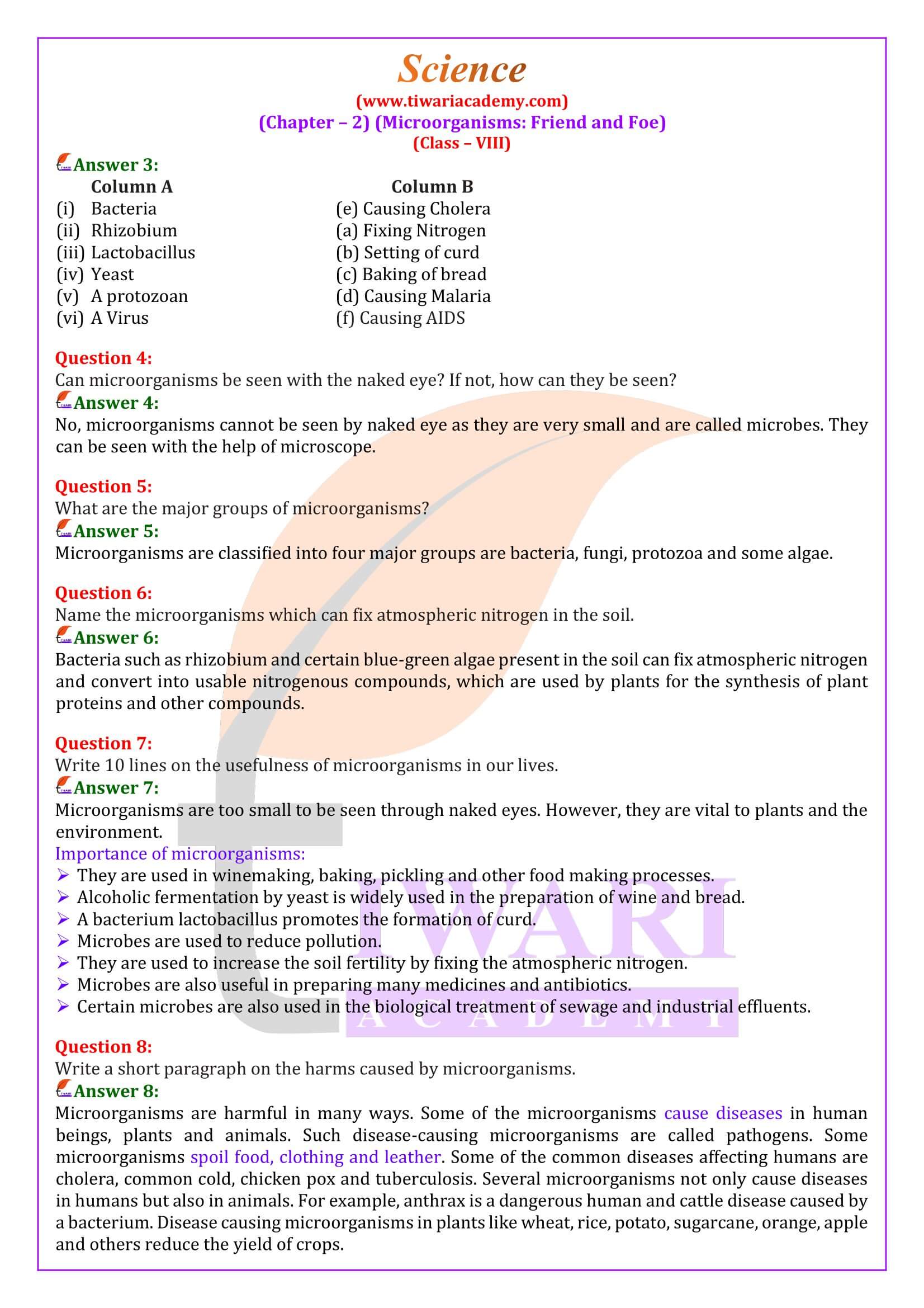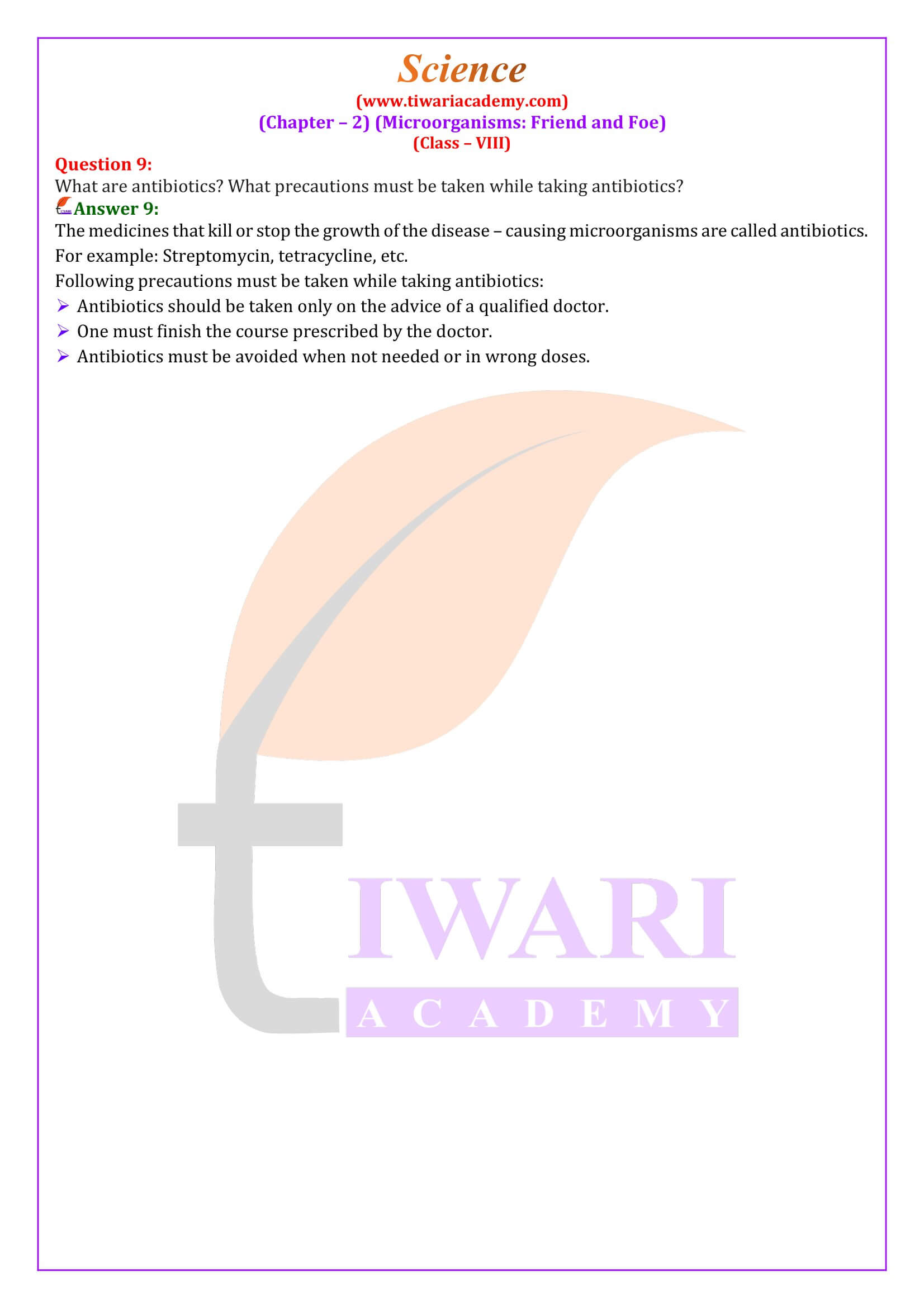Question Wise Class 8 Science Chapter 2 Solutions
Class 8 Science Chapter 2 NCERT Answers
Class 8 Science Chapter 2 in Hindi Medium
Class 8 Science Chapter 2 Extra Questions
Class 8 Science Chapter 2 MCQ
Class 8 Science NCERT Book Download
Class 8 Science Chapter 2 Exemplar Book
Class 8 Science Chapter 2 Exemplar Answers
Class 8 Science NCERT Solutions
Class 8 all Subjects NCERT Solutions
NCERT Solutions for Class 8 Science Chapter 2 Microorganisms Friend and Foe in English and Hindi Medium to Study Online or Download in PDF file format updated for new academic session 2025-26 following the latest CBSE Syllabus. Visit to NCERT Solutions main page to get all Subjects. The solutions are based on new NCERT books published for 2025-26 exams.
| Class: 8 | Science |
| Chapter 2: | Microorganisms: Friend and Foe |
| Content: | NCERT Solutions, MCQ & Extra Questions |
| Mode of Content: | PDF, Text and Videos |
| Session: | 2025-26 |
| Medium: | Hindi and English |
Class 8 Science Chapter 2 NCERT Solutions
- Class 8 Science Chapter 2 Question Answers
- Class 8 Science Chapter 2 in Hindi Medium
- Class 8 Science Chapter 2 Extra Questions
- Class 8 Science Chapter 2 MCQ
- Class 8 Science Chapter 2 NCERT Book
- Class 8 Science Chapter 2 Exemplar Book
- Class 8 Science Chapter 2 Exemplar Answers
- Class 8 Science NCERT Solutions
- Class 8 all Subjects NCERT Solutions
Class 8 Science Chapter 2 Answers
NCERT Solutions for Class 8 Science Chapter 2 Microorganisms: Friend and Foe is given below. Video Format solution based on NCERT Solutions 2025-26 is also available. Download 8 Science App for offline use for new session.
Class 8 Science Chapter 2 Explanation in Videos
Important Terms on Class 8 Science Chapter 2
1. Microorganisms
This part of chapter 2 of Class 8 Science focuses a branch of microbiology which introduced the importance of microorganism in our ecosystem. We have seen several kinds of plants and animals. However, there are many living organisms around us which we cannot see with eyes alone. These are called microorganisms or microbes, such as bacteria, fungi, protozoa and some algae. For example, you might have observed that during rainy season moist bread gets to spoil and its surface gets covered with greyish-white patches.
2. Microorganisms and Diseases
Remember, water and soil are full of tiny organisms, but all of them not comes into microorganisms or microbe’s category. Do you know? Viruses are also microorganisms. They reproduce only inside the cells of the host organisms and cause serious disease like Polio, Chickenpox, Common cold. Diseases like Typhoid, Tuberculosis are bacterial diseases which are caused by protozoans.
3. Where do Microorganisms Live?
Microorganisms can survive under all types of environment, ranging from ice cold climate to hot springs and deserts to marshy lands. They are also found in polluted air and water as well as in inside the bodies of animals, including humans. Remember, microorganisms like amoeba can live alone while fungi and bacteria may live in colonies.
4. Microorganisms and Us
In this part of the content discusses the role of microorganisms, if microorganisms are good or bad for us. Thus, this part of the chapter will help, to an extent, in clearing this matter. As you know, that microorganisms play an essential role in our lives. Some of them are beneficial in many ways, whereas some others are harmful and causes diseases. They are used for various friendly purposes as they are used in cleaning up of the environment. For example, the organic wastes (vegetable peels, remains of animals, faeces etc.) are broken down into harmless and usable substance by bacteria, called manure. In agriculture, they are used to increase soil fertility by fixing nitrogen.
5. Microorganisms as a Friends
You may know that microorganisms are used for the preparation of curd, bread and cake. Curd contains several microorganisms. The bacterium Lactobacillus promotes the formation of curd. Similarly, yeast is also used in the baking industry for making slices of bread, pastries and cakes. Microorganisms are also used for the large-scale production of alcohol, wine and acetic acid. As yeast is used for the smell of alcohol as sugar converts into alcohol. The process of conversion of sugar into alcohol is called ‘fermentation’.
6. Microorganisms in Medicine
Whenever we fall ill, the doctor gives us some antibiotic tablets, capsule or injection. The sources of these medicines are microorganisms. Do you think why they are used? These medicines kill or stop the growth of the disease-causing microorganisms. Hence, such medicines are called ‘Antibiotics’. Antibiotics are even mixed with the feed of livestock and poultry to check microbial infection in animals. They are also used to control many plant diseases. When a disease-carrying microbe enters our body, the body produces ‘antibodies’ to fight the invader. In our childhood, we must have been given an injection for ‘Smallpox’ and ‘Polio’ to protect our-self against these diseases. Generally, these vaccines are made from microbes or microorganisms.
7. Microorganisms as Decomposer
As you learn before, some bacteria and blue-green algae are able to fix nitrogen from the atmosphere to enrich the soil with nitrogen and increase its fertility. You often see a large amount of dead organic matter in the form of decaying plants and dead animals on the ground. You find that they disappear after some time. This is because the microorganisms decompose dead organic waste of plants and animals, converting them into manure or nutrients. The other plants and animals again use these substances.
8. Harmful Microorganisms
This part of the Class 8 Science deals with some diseases which are caused by microorganisms. Microorganisms are harmful in many ways. Some of the microorganisms cause diseases in human beings, plants and animals, called ‘Pathogens’.
9. Disease – Causing Microorganisms in Humans
Microbial diseases that can spread from an infected person to a healthy person through the air, water, food or physical contact, called ‘Communicable Diseases’. When a person suffering from common cold sneezes, fine droplets of moisture carrying thousands of viruses are spread in the air, and then through the air, the virus enters the body of a healthy person while breathing. There are some insects and animals which act as ‘carriers’ of diseases causing microbes. Such as houseflies, mosquitoes, cockroach etc. Remember, ‘Anopheles Mosquito’ which careers the parasite of malaria. ‘Female Aedes’ mosquito act as a carrier of the dengue virus.
10. Disease – Causing Microorganisms in Animals and Plants
Anthrax is a dangerous human and cattle disease caused by the bacterium. Several microorganisms are there which causes diseases in plants like wheat, rice, potato, sugarcane, orange, apple and others. These diseases reduce the yield of crops. Microorganisms that grow on our food sometimes produce toxic substances. These make the food poisonous, causing severe illness and even death.
11. Food Preservation
In this part of the content gives an idea about food preservation from microorganism or microbes. As you know, spoilt food emits a bad smell and has a bad taste and change colour. So, it is very important that we preserve food to prevent it from being spoilt. Salt and edible oils are common chemicals generally used to check the growth of microorganisms, called ‘Preservatives’. Common salt has been used to preserve meat and fish for ages. Jams, jellies and squashes are preserved by sugar. As you know, boiling kills many microorganisms. You must have noticed that your mother is boiling milk before it is stored or used. Now in a day, dry fruits and even vegetables are sold in sealed airtight packets to prevent the attack of microbes.
12. Nitrogen Cycle
We know that our atmosphere has 78% nitrogen gas. Light and Nitrogen are the essential constituents of all living organisms as part of proteins, chlorophyll, nucleic acid and vitamins. Nitrogen cannot be taken by plants and animals directly. Certain bacteria and blue-green algae fix the nitrogen from the atmosphere and convert into compounds of nitrogen in the soil. When plants and animals die, bacteria and fungi convert the nitrogenous waste into nitrogenous compounds. And again, used by plants. As a result, the percentage of nitrogen in the atmosphere remains constant.
13. Nitrogen Fixation
As you know, the involvement of rhizobium bacteria in the fixation of nitrogen for leguminous plants. Rhizobium lives in the root nodules of leguminous plants and converts nitrogen into a soluble form for them. But that bacteria cannot make their own food. In return, leguminous plants provide food and shelter to the rhizobium bacteria. In this way, you can see microorganisms have tons of benefits, and they can cause deadly diseases too. As they are crucial in maintaining a balance in our ecological system, which helps to survive all living organisms.
Class 8 Science Chapter 2 Important Questions for Practice
Class 8 Science Chapter 2 Extra Questions
Can microorganisms be seen with the naked eye? If not, how can they be seen?
No, microorganisms cannot be seen by naked eye as they are very small and are called microbes. They can be seen with the help of microscope.
What are the major groups of microorganisms?
Microorganisms are classified into four major groups are bacteria, fungi, protozoa and some algae.
Name the microorganisms which can fix atmospheric nitrogen in the soil.
Bacteria such as rhizobium and certain blue-green algae present in the soil can fix atmospheric nitrogen and convert into usable nitrogenous compounds, which are used by plants for the synthesis of plant proteins and other compounds.
What are antibiotics? What precautions must be taken while taking antibiotics?
The medicines that kill or stop the growth of the disease – causing microorganisms are called antibiotics.
For example: Streptomycin, tetracycline, etc.
Following precautions must be taken while taking antibiotics:
Antibiotics should be taken only on the advice of a qualified doctor.
One must finish the course prescribed by the doctor.
Antibiotics must be avoided when not needed or in wrong doses.
Class 8 Science Chapter 2 MCQ with Answers
1. Which of the following reproduces only inside a host cell?
(a) Bacteria
(b) Virus
(c) Amoeba
(d) Fungus.
2. Paheli dug two pits, A and B, in her garden. In pit A, she put a polythene bag packed with some agricultural waste. In pit B, she dumped the same kind of waste but without packing it in a polythene bag. She, then covered both the pits with soil. What did she observe after a month?
(a) Waste in pit A degraded faster than that in pit B.
(b) Waste in pit B degraded faster than that in pit A.
(c) Waste in both pits degraded almost equally.
(d) Waste in both pits did not degrade at all.
3. A disease in human beings caused by virus is _______.
(a) typhoid
(b) influenza
(c) dysentry
(d) cholera
4. The two micro-organisms which live in symbiotic association in lichens are
(a) fungus and protozoa
(b) alga and bacteria
(c) bacteria and protozoa
(d) alga and fungus
5. The disease caused by a protozoan and spread by an insect is _________.
(a) dengue
(b) malaria
(c) polio
(d) measles
6. The gas released during the preparation of bread is
(a) oxygen
(b) carbon dioxide
(c) nitrogen
(d) sulphur dioxide
7. Pathogenic micro-organisms present in host cells are killed by medicines called
(a) pain killer
(b) antibodies
(c) antibiotics
(d) vaccines
8. Unscramble the jumbled words underlined in the following statements.
(a) Cells of our body produce santiidobe to fight pathogens.
(b) curbossulite is an air-borne disease caused by a bacterium.
(c) Xanrhat is a dangerous bacterial disease.
(d) Yeasts are used in the wine industry because of their property of meronettinaf.
Answers of Important Questions
1 (b)
2 (b)
3 (b)
4 (d)
5 (b)
6 (b)
7 (c)
8 (a) antibodies (b) tuberculosis (c) Anthra (d) fermentation
Ask your doubts and share your knowledge with your friends and other users through Discussion Forum. Download NCERT Books for new academic session 2025-26.






